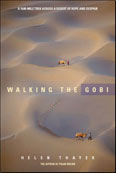

| | 
|

Praise for Walking the Gobi...
USA Today
While her feat was a first, Thayer is prouder of the fact that the expedition was cheap and efficient; that it had near-zero environmental impact; and that it was worth something to somebody else.
The Oregonian
Polar Dream: The First Solo Expedition by a Woman and Her Dog to the Magnetic North Pole. Second Edition NewSage Press
I was hooked on this book within the first few pages. I cheered for Charlie the dog when he warned the author of polar bear attacks, and held my breath when Charlie actually ran across the ice in pursuit of one. Thayer and Charlie face the elements as a true team. This book is a heart stopping adventure tale, an informative narrative of the world of the frozen north and a dog-human love story, all in one great package.
Publishers Weekly
A 50 year old New Zealand woman set out from Resolute Bay, Canada and became the first woman to walk alone, pulling her own sled full of supplies to the magnetic North Pole without dog teams, snowmobiles or other humans. A black Inuit husky dog she named Charlie walked at her side as protection against polar bears. He saved her life against at least one attack. It was a grueling journey: woman and dog confronted polar bears, barely escaped drowning, and survived violent storms. This is an exciting story of human endurance and of a remarkable dog.
La Joie -- Summer 2003
Thayer's life as an adventurer, mountain climber, and explorer immediately appealed to me. In 2001 at age 63 she trekked with her husband across the entire Mongolian Gobi Desert, 1,450 miles. She undertook 1,200 miles of kayaking through the Amazon, a 2,400 mile trek across the Sahara Desert and to celebrate her 60th birthday she trekked solo 400 miles in Antarctica. But it is the magnetic North Pole expedition, walking and skiing for 27 days, pulling a 160 pound sled for 364 miles with Charlie that gave me the greatest insight into a woman of unbeatable courage and stamina, despite encounters with often viscous polar bears, violent weather, and her loneliness and fear bordering too often on terror.
On day eleven she writes: "Charlie walked slightly in front of me, a position he automatically took when a bear was close. When he began a slow quiet growl I wondered with growing fear if the bear had stopped again. Ice cubes were sitting in the pit of my stomach and my heart was pounding. If I continued forward I might be ambushed and I couldn't depend on waiting her out. Bears are very patient animals. I needed a new plan."
In one of many passages that show the deep devotion Thayer and Charlie have for each other, she writes: "I went back to Charlie and sat on his sled. He leaned on me, laying his big black head on my knee. I stroked his silky black ears and talked to him about my thoughts and plans for the days ahead. After a few minutes I heard the gentlest of snores. Charlie had fallen asleep on my lap."
In the epilogue, the author remarks, "To this day I am grateful for the close bond that developed so quickly and so permanently between Charlie and me. This had an impact on my life as much as the expedition itself. As we traveled day after day to the Pole I learned that humans have a lot to learn from our canine friends--unconditional trust, love, and a friendship that never ceases."
Included in the text are 30 outstanding photographs taken by the author during her expedition. Altogether, Polar Dream presents not only adventure of the finest kind, but in Helen Thayer, the best of humanity, qualities unsurpassed and definitely to be aspired to. Polar Dream is a gift to give yourself and everyone you know.
Outside Magazine
As she recounts in Polar Dream , at the age of 50, five feet two inch Helen Thayer skied alone with an Inuit husky she named Charlie to the magnetic North Pole to become the first woman to do so. Drawing on her experience among the fjords, crags and glaciers of New Zealand, and her experience as a mountain guide and ski racer she skied and walked for 365 miles having braved polar bears, ice floes, and violent storms. "This was a journey of credits and debits," she noted in her journal early on. "Every time I slipped into the debit column, I had to pull myself over into the credit column without delay." Her eloquent account of the trip is a pleasure to read.
|


|

|